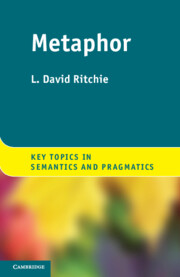Book contents
- Frontmatter
- Contents
- Figures
- Acknowledgments
- 1 Introduction
- 2 Understanding metaphors
- 3 Categorization and relevance
- 4 Conceptual metaphors
- 5 Perceptual simulation
- 6 Metaphors and framing effects
- 7 Language play
- 8 Metaphors in conversation
- 9 Metaphors in politics
- 10 Metaphors in literature
- 11 Closing reflections
- Glossary
- Bibliography
- Index
8 - Metaphors in conversation
Published online by Cambridge University Press: 05 February 2013
- Frontmatter
- Contents
- Figures
- Acknowledgments
- 1 Introduction
- 2 Understanding metaphors
- 3 Categorization and relevance
- 4 Conceptual metaphors
- 5 Perceptual simulation
- 6 Metaphors and framing effects
- 7 Language play
- 8 Metaphors in conversation
- 9 Metaphors in politics
- 10 Metaphors in literature
- 11 Closing reflections
- Glossary
- Bibliography
- Index
Summary
Well that’s the journey that I’ve – I’ve been on … the journey’s … been an inner journey … of transforming the – the feelings that were there at the beginning … the pain … and the loss … and the anger … and the grief … and … discovering that they can be transformed.
(Jo Berry [Reconciliation Talks], quoted in Cameron [2007])Cameron (2007; 2009) argues that our understanding of social interactions and the contexts in which they occur can be improved by close attention to the pattern of metaphor use and storytelling, and incorporates these elements into an analytic method, Dynamic Discourse Analysis. Based on her research in elementary school classrooms, in the Reconciliation Talks, and in other conversational settings, Cameron has identified several patterns of thematic metaphor use. In this chapter I will discuss several ways in which metaphors are used in casual conversations, often in combination with humor, irony, and storytelling. I will begin with a review of Cameron’s (2007) research on the Reconciliation Talks.
PATTERNS OF METAPHOR USE AND RE-USE
In October 1984 a bomb exploded in the Grand Hotel in Brighton, England, where Prime Minister Margaret Thatcher and several Members of Parliament were staying. Five people were killed by the blast, including Sir Anthony Berry. Pat Magee, the Irish Republican Army Operative who had planted the bomb several weeks earlier, was later caught and imprisoned, then released under a peace agreement in 1999. Soon after the bombing, Sir Anthony Berry’s daughter Jo Berry undertook what she described as “a journey of healing,” attempting to understand the motives behind the bombing and the events that led to her father’s death. This process led to a private face-to-face meeting with Magee in late 2000, at Berry’s request. That initial meeting led to a series of further conversations between the two, some of which were video recorded, as well as to a series of joint public appearances and a television documentary. Through these conversations Berry and Magee became friends and collaborators in a peace-building project designed to bring about reconciliation in Northern Ireland and help other victims of the conflict.
- Type
- Chapter
- Information
- Metaphor , pp. 140 - 160Publisher: Cambridge University PressPrint publication year: 2013



